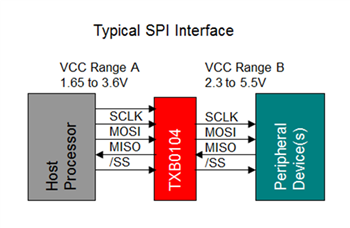SSZTC99 August 2015 TXB0104-Q1
Ever wondered, how your map stays on track inside the car navigation systems when go inside the tunnel? Gyro sensors are extensively used in car navigation systems for sensing angular velocity changes in the travel direction and for dead reckoning in locations where GPS signals are lost. These sensors transfer the data over SPI interface. As advancements in host processors are migrating to smaller, lower power, faster, smaller geometry process technology while I/O voltage of peripheral devices may still be at higher legacy voltages, that’s where TI’s TXB0104-Q1 comes in. It’s a 4-Bit Bidirectional Voltage-Level Translator with auto direction sensing. The auto-direction sensing translators eliminates direction control signals and associated software (see Figure 1).
 Figure 1 Typical SPI Interface
Figure 1 Typical SPI InterfaceIf you have an application, such as SPI, which has a mixture of bits going to different directions, the TXB product can handle it effortlessly. TXB requires no direction control signal saving GPIOs on the processor, resulting in simpler software driver development. Additionally, it has integrated high ESD protection eliminating the need for external ESD protection, and up to data rates of 100 Mbps. The TXB is available in the small WCSP NanoFree and BGA Packages, which assures for a robust system design. The part supports 1.2 V to 3.6 V on A Port and 1.65 V to 5.5 V on B Port (VCCA ≤ VCCB). More detail can be found at this link: TXB0104-Q1.